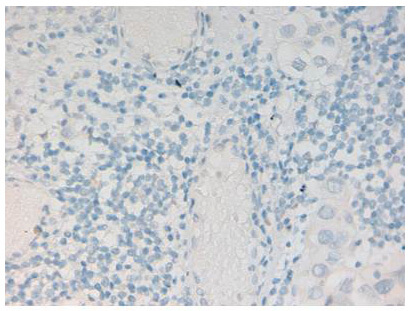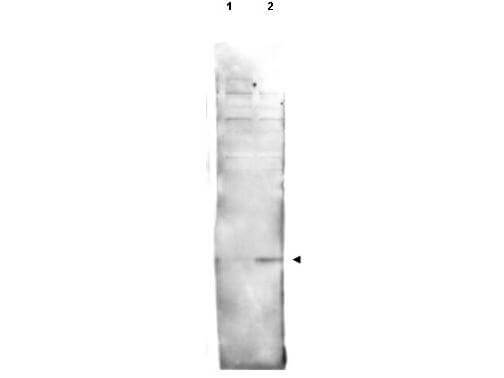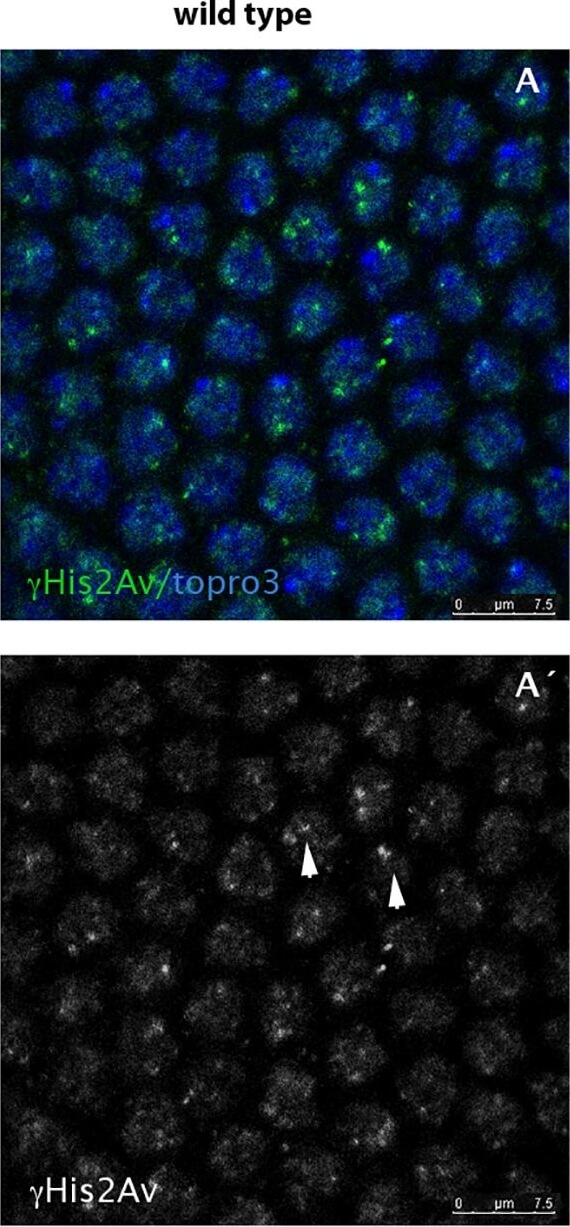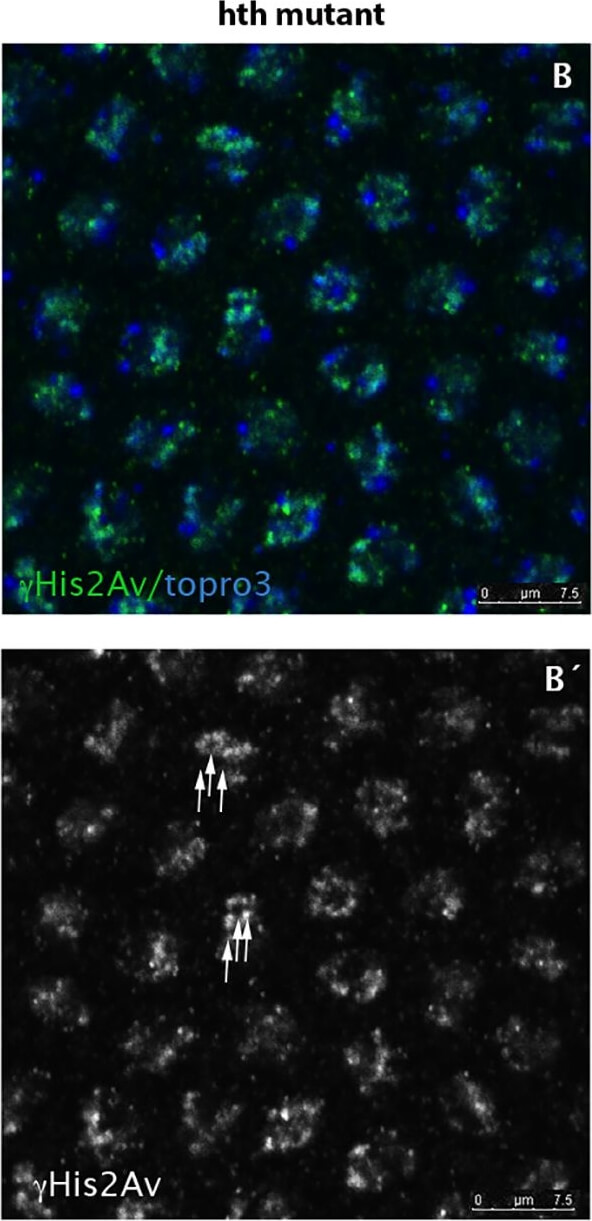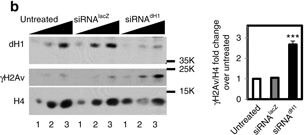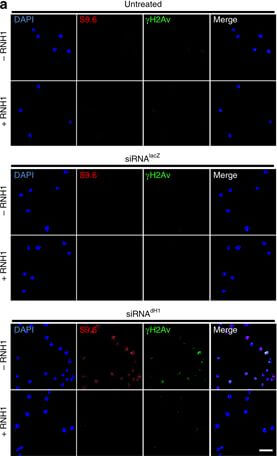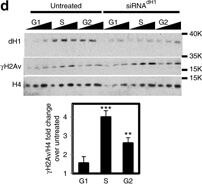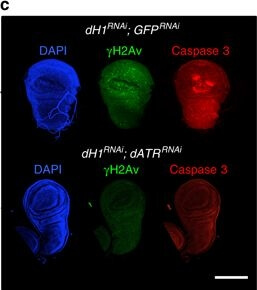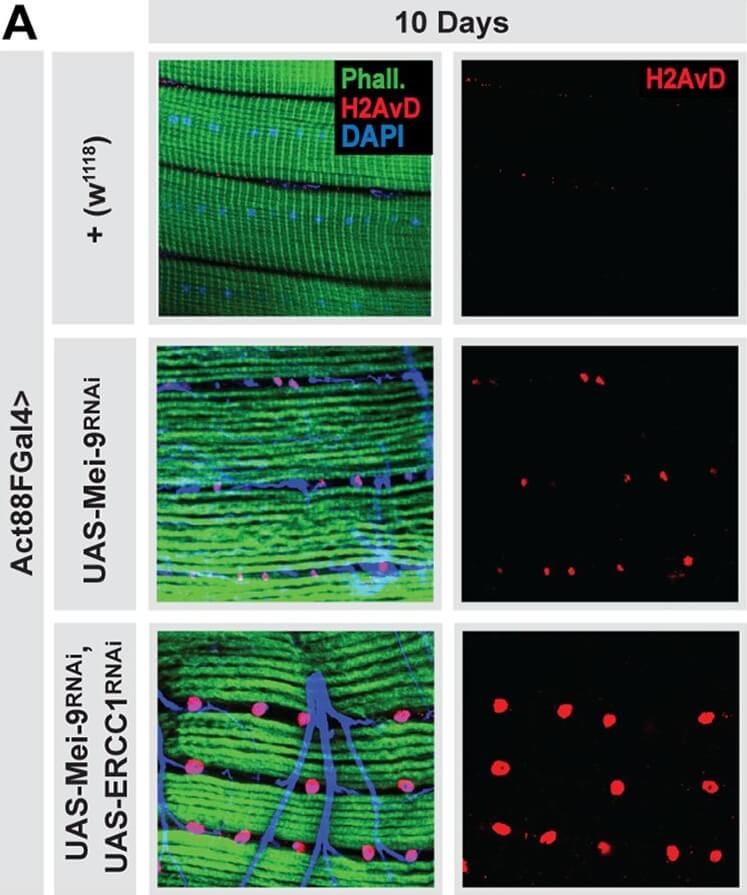Datasheet is currently unavailable. Try again or CONTACT US
Histone H2AvD phosphoS137 Antibody
Rabbit Polyclonal
66 References
600-401-914S
600-401-914
25 µL
100 µg
Liquid (sterile filtered)
Liquid (sterile filtered)
WB, ELISA, IHC, IF, ChIP, EM, Multiplex
D. melanogaster
Rabbit
Shipping info:
$50.00 to US & $70.00 to Canada for most products. Final costs are calculated at checkout.
Product Details
Anti-Histone H2AvD pS137 (RABBIT) Antibody - 600-401-914
rabbit anti-H2AvD pS137 antibody, rabbit anti-Histone H2A.v pS137 antibody, H2AvD protein antibody, H2A.F/Z, H2A.Z, H2AvD, His2AvD, His2Av
Rabbit
Polyclonal
IgG
Target Details
His2Av - View All His2Av Products
D. melanogaster
Phosphorylation
Conjugated Peptide
Histone H2AvD pS137 Antibody was prepared from whole rabbit serum produced by repeated immunizations with a synthetic peptide corresponding to the C-Terminal region near amino acids 125-141 of Drosophila melanogaster (fruit fly) H2AvD protein.
Affinity purified Anti-Histone H2AvD pS137 Antibody is directed against the phosphorylated form of Drosophila H2AvD protein at the pS137 residue. The product was affinity purified from monospecific antiserum by immunoaffinity purification. Antiserum was first purified against the phosphorylated form of the immunizing peptide. The resultant affinity purified antibody was then cross-adsorbed against the non-phosphorylated form of the immunizing peptide. Reactivity occurs against Drosophila H2AvD pS137 protein and the antibody is specific for the phosphorylated form of the protein. Reactivity with non-phosphorylated Drosophila H2AvD is minimal by ELISA. A BLAST analysis was used to suggest little to no cross reactivity with H2AvD proteins from other sources based on a comparison using the immunizing sequence. Reactivity against homologues from other sources is not known.
Application Details
ELISA, IHC, WB
ChIP, EM, IF, Multiplex
- View References
Histone H2AvD pS137 Antibody is tested in ELISA, Immunohistochemistry, and by western blot. Specific conditions for reactivity should be optimized by the end user. Expect a band approximately 14 kDa in size corresponding to phosphorylated H2AvD protein by western blotting in the appropriate Drosophila tissue or cell lysate or extract. Minimal reactivity is observed against the non-phosphorylated form of the immunizing peptide. This antibody is phospho specific for pS137 of H2AvD protein.
Formulation
1.1 mg/ml by UV absorbance at 280 nm
0.02 M Potassium Phosphate, 0.15 M Sodium Chloride, pH 7.2
0.01% (w/v) Sodium Azide
None
Shipping & Handling
Dry Ice
Store vial at -20° C prior to opening. Aliquot contents and freeze at -20° C or below for extended storage. Avoid cycles of freezing and thawing. Centrifuge product if not completely clear after standing at room temperature. This product is stable for several weeks at 4° C as an undiluted liquid. Dilute only prior to immediate use.
Expiration date is one (1) year from date of receipt.
This antibody is designed, produced, and validated as part of a collaboration between Rockland and the National Cancer Institute (NCI) and is suitable for Cancer, Immunology and Nuclear Signaling research. Variant histones H2A are synthesized throughout the cell cycle and are very different from classical S-phase regulated H2A. H2AvD is vital for viability, but the exact function of variant histones H2A is not known. H2A is a core component of the nucleosome, an octamer containing two molecules each of H2A, H2B, H3 and H4. The octamer wraps approximately 146 bp of DNA. HsAvD is expressed both maternally and zygotically and is found in embryos through to adults (female only). The human homologue, H2AX, is phosphorylated by ATM protein kinase when double strand DNA breaks occur. In mouse, H2AX ''knock out'' mice have an increased incidence of cancer.
Pilesi E et al. (2024). Vitamin B6 deficiency cooperates with oncogenic Ras to induce malignant tumors in Drosophila. Cell Death Dis.
Applications
IF, Confocal Microscopy
Parrella P et al. (2024). Bleomycin reduces Vairimorpha (Nosema) ceranae infection in honey bees with some evident host toxicity. Microbiol Spectr.
Applications
WB, IB, PCA
Chauvin SD et al. (2024). Inherited C-terminal TREX1 variants disrupt homology-directed repair to cause senescence and DNA damage phenotypes in Drosophila, mice, and humans. Nat Commun.
Applications
IHC, ICC, Histology
Rye T et al. (2024). Nup153 is not required for anchoring heterochromatic DSBs to the nuclear periphery. MicroPubl Biol.
Applications
IF, Confocal Microscopy
Guo T et al. (2024). Impaired dNKAP function drives genome instability and tumorigenic growth in Drosophila epithelia. J Mol Cell Biol.
Applications
IF, Confocal Microscopy
Watase GJ et al. (2024). RNA polymerase II-mediated rDNA transcription mediates rDNA copy number expansion in Drosophila. PLoS Genet.
Applications
IF, Confocal Microscopy
Tu R et al. (2023). Gap junction-transported cAMP from the niche controls stem cell progeny differentiation. Proc Natl Acad Sci U S A.
Applications
IF, Confocal Microscopy
Torre M et al. (2023). A Drosophila model relevant to chemotherapy-related cognitive impairment. Sci Rep.
Applications
IF, Confocal Microscopy; IHC, ICC, Histology
Fontana P et al. (2023). Serine ADP-ribosylation in Drosophila provides insights into the evolution of reversible ADP-ribosylation signalling. Nat Commun.
Applications
WB, IB, PCA
Chang YH et al. (2023). Endogenous retroviruses and TDP-43 proteinopathy form a sustaining feedback driving intercellular spread of Drosophila neurodegeneration. Nat Commun.
Applications
IF, Confocal Microscopy
Zhang Q et al. (2023). Phase separation of BuGZ regulates gut regeneration and aging through interaction with m6A regulators. Nat Commun.
Applications
IF, Confocal Microscopy
Torre M et al. (2023). A Drosophila model relevant to chemotherapy-related cognitive impairment. Sci Rep.
Applications
IF, Confocal Microscopy; IHC, ICC, Histology
Crucianelli C et al. (2023). Distinct signaling signatures drive compensatory proliferation via S-phase acceleration. PLoS Genet.
Applications
IF, Confocal Microscopy
González-Marín B et al. (2023). ATM/Chk2 and ATR/Chk1 Pathways Respond to DNA Damage Induced by Movento® 240SC and Envidor® 240SC Keto-Enol Insecticides in the Germarium of Drosophila melanogaster. Toxics.
Applications
IF, Confocal Microscopy
Richards L et al. (2022). Nucleoporins facilitate ORC loading onto chromatin. Cell Rep.
Applications
IF, Confocal Microscopy
O'Neill RS et al. (2022). Traip controls mushroom body size by suppressing mitotic defects. Development
Applications
IF, Confocal Microscopy
Munden, A et al. (2022). Identification of replication fork-associated proteins in Drosophila embryos and cultured cells using iPOND coupled to quantitative mass spectrometry. Scientific Reports
Applications
IF, Confocal Microscopy
Gemble, S et al. (2022). Genetic instability from a single S phase after whole-genome duplication. Nature
Applications
IF, Confocal Microscopy
Tu R et al. (2021). Multiple Niche Compartments Orchestrate Stepwise Germline Stem Cell Progeny Differentiation. Curr Biol.
Applications
IF, Confocal Microscopy
Liu J et al. (2021). NMNAT promotes glioma growth through regulating post-translational modifications of P53 to inhibit apoptosis. Elife.
Applications
WB, IB, PCA
Lattao R et al. (2021). Mauve/LYST limits fusion of lysosome-related organelles and promotes centrosomal recruitment of microtubule nucleating proteins. Dev Cell.
Applications
IF, Confocal Microscopy
Casale AM et al. (2021). Transposable element activation promotes neurodegeneration in a Drosophila model of Huntington's disease. iScience
Applications
IF, Confocal Microscopy
Hatkevich t et al. (2021). A pathway for error-free non-homologous end joining of resected meiotic double-strand breaks. Nucleic Acids Res.
Applications
IF, Confocal Microscopy
Mascolo E et al. (2020). Pyridoxine/pyridoxamine 5′‐phosphate oxidase (Sgll/PNPO) is important for DNA integrity and glucose homeostasis maintenance in Drosophila. J Cell Biol.
Applications
IF, Confocal Microscopy
Rastegari E et al. (2020). WD40 protein Wuho controls germline homeostasis via TRIM-NHL tumor suppressor Mei-p26 in Drosophila. Development.
Applications
IF, Confocal Microscopy
Palladino J et al. (2020). Targeted de novo centromere formation in Drosophila reveals plasticity and maintenance potential of CENP-A chromatin. Dev Cell.
Applications
IF, Confocal Microscopy
Na HJ et al. (2020). Nutrient-driven O-GlcNAcylation controls DNA damage repair signaling and stem/progenitor cell homeostasis. Cell Rep.
Applications
IHC, ICC, Histology
Lin KY et al. (2020). Piwi reduction in the aged niche eliminates germline stem cells via Toll-GSK3 signaling. Nat Commun.
Applications
IF, Confocal Microscopy
Merigliano C et al. (2019). A new role for Drosophila Aurora-A in maintaining chromosome integrity. Chromosoma.
Applications
IF, Confocal Microscopy
Cosolo A et al. (2019). JNK-dependent cell cycle stalling in G2 promotes survival and senescence-like phenotypes in tissue stress. Elife
Applications
IHC, ICC, Histology
Okumura K et al. (2019). Genetic identification and characterization of three genes that prevent accumulation of oxidative DNA damage in Drosophila adult tissues. DNA Repair (Amst).
Applications
IF, Confocal Microscopy
Tsakiri EN et al. (2019). Proteasome dysfunction induces excessive proteome instability and loss of mitostasis that can be mitigated by enhancing mitochondrial fusion or autophagy. Autophagy.
Applications
IF, Confocal Microscopy; WB, IB, PCA
Murcia L et al. (2019). Selective killing of RAS-malignant tissues by exploiting oncogene-induced DNA damage. Cell Rep.
Applications
IF, Confocal Microscopy
Grendler J et al. (2019). Wound-induced polyploidization is driven by Myc and supports tissue repair in the presence of DNA damage. Development.
Applications
IHC, ICC, Histology
Dialynas G et al. (2019). Arp2/3 and Unc45 maintain heterochromatin stability in Drosophila polytene chromosomes. Exp Biol Med (Maywood).
Applications
IF, Confocal Microscopy
Chang YH et al. (2019). The gypsy endogenous retrovirus drives non-cell-autonomous propagation in a Drosophila TDP-43 model of neurodegeneration. Curr Biol.
Applications
IF, Confocal Microscopy
Perlmutter JI et al. (2019). The phage gene wmk is a candidate for male killing by a bacterial endosymbiont. PLoS Pathog.
Applications
IF, Confocal Microscopy
Nano M et al. (2019). Cell-cycle asynchrony generates DNA damage at mitotic entry in polyploid cells. Curr Biol.
Applications
IF, Confocal Microscopy
Harumoto et al. (2018). Male-killing toxin in a bacterial symbiont of Drosophila. Nature
Applications
IF, Confocal Microscopy
Mlih et al. (2018). A virus-acquired host cytokine controls systemic aging by antagonizing apoptosis. PLOS Biology
Applications
IF, Confocal Microscopy; Multiplex Assay
Merigliano et al. (2018). Protective role of vitamin B6 (PLP) against DNA damage in Drosophila models of type 2 diabetes. Scientific Reports
Applications
IF, Confocal Microscopy
McCarthy et al. (2018). Tip60 complex promotes expression of a differentiation factor to regulate germline differentiation in female Drosophila. Molecular Biology of the Cell
Applications
IF, Confocal Microscopy
Feng L et al. (2018). Enhancer of polycomb maintains germline activity and genome integrity in Drosophila testis. Cell Death Differ.
Applications
IF, Confocal Microscopy
Clemot M et al. (2018). The replicative histone chaperone CAF1 is essential for the maintenance of identity and genome integrity in adult stem cells. Development.
Applications
IF, Confocal Microscopy
Caridi CP et al. (2018). Nuclear F-actin and myosins drive relocalization of heterochromatic breaks. Nature
Applications
WB, IB, PCA
Delabaere et al. (2017). Aging impairs double-strand break repair by homologous recombination in Drosophila germ cells. Aging Cell
Applications
IF, Confocal Microscopy
Merigliano et al. (2017). A Role for the Twins Protein Phosphatase (PP2A-B55) in the Maintenance ofDrosophilaGenome Integrity. Genetics
Applications
IHC, ICC, Histology; WB, IB, PCA
Koehler et al. (2017). Pink1 and Parkin regulate Drosophila intestinal stem cell proliferation during stress and aging. Journal of Cell Biology
Applications
IHC, ICC, Histology
Bayona-Feliu et al. (2017). Linker histone H1 prevents R-loop accumulation and genome instability in heterochromatin. Nature Communications
Applications
ChIP; IF, Confocal Microscopy; WB, IB, PCA; Multiplex Assay
Ma X et al. (2017). Aubergine controls germline stem cell self-renewal and progeny differentiation via distinct mechanisms. Dev Cell.
Applications
IHC, ICC, Histology
Guarner A et al. (2017). E2F/DP prevents cell-cycle progression in endocycling fat body cells by suppressing dATM expression. Dev Cell.
Applications
IF, Confocal Microscopy
Colmenares SU et al. (2017). Drosophila histone demethylase KDM4A has enzymatic and non-enzymatic roles in controlling heterochromatin integrity. Dev Cell.
Applications
IF, Confocal Microscopy
Upadhyay et al. (2016). Transposon Dysregulation Modulates dWnt4 Signaling to Control Germline Stem Cell Differentiation in Drosophila. PLOS Genetics
Applications
WB, IB, PCA
Chen et al. (2016). Age-associated de-repression of retrotransposons in the Drosophila fat body, its potential cause and consequence. Aging Cell
Applications
Immuno-EM
Ham et al. (2016). Glycine restores the anabolic response to leucine in a mouse model of acute inflammation. American Journal of Physiology-Endocrinology and Metabolism
Applications
WB, IB, PCA
Swenson et al. (2016). The composition and organization of Drosophila heterochromatin are heterogeneous and dynamic. Elife
Applications
IHC, ICC, Histology
Hong et al. (2016). Antagonistic roles of Drosophila Tctp and Brahma in chromatin remodelling and stabilizing repeated sequences. Nature Communications
Applications
IHC, ICC, Histology
Ma et al. (2016). DNA damage-induced Lok/CHK2 activation compromises germline stem cell self-renewal and lineage differentiation. Development
Applications
IHC, ICC, Histology
Zaballos et al. (2015). The TALE Transcription Factor Homothorax Functions to Assemble Heterochromatin during Drosophila Embryogenesis. PLOS One
Applications
IF, Confocal Microscopy
Ryu et al. (2015). Heterochromatic breaks move to the nuclear periphery to continue recombinational repair. Nature Cell Biology
Applications
WB, IB, PCA
Vo N et al. (2014). Drosophila Mcm10 is required for DNA replication and differentiation in the compound eye. PLoS One.
Applications
IF, Confocal Microscopy
Perez-Montero S et al. (2013). The embryonic linker histone H1 variant of Drosophila, dBigH1, regulates zygotic genome activation. Dev Cell.
Applications
IF, Confocal Microscopy
Hong ST et al. (2013). TCTP directly regulates ATM activity to control genome stability and organ development in Drosophila melanogaster. Nat Commun.
Applications
IHC, ICC, Histology
Chmielewski JP et al. (2012). Drosophila Psf2 has a role in chromosome condensation. Chromosoma.
Applications
IF, Confocal Microscopy
Vujatovic O, Zaragoza K, Vaquero A, Reina O, Bernués J, Azorín F. (2012). Drosophila melanogaster linker histone dH1 is required for transposon silencing and to preserve genome integrity. Nucleic Acids Res.
Applications
IF, Confocal Microscopy
Bosveld F, Rana A, van der Wouden PE, et al. (2008). De novo CoA biosynthesis is required to maintain DNA integrity during development of the Drosophila nervous system. Hum Mol Genet.
Applications
IHC, ICC, Histology
This product is for research use only and is not intended for therapeutic or diagnostic applications. Please contact a technical service representative for more information. All products of animal origin manufactured by Rockland Immunochemicals are derived from starting materials of North American origin. Collection was performed in United States Department of Agriculture (USDA) inspected facilities and all materials have been inspected and certified to be free of disease and suitable for exportation. All properties listed are typical characteristics and are not specifications. All suggestions and data are offered in good faith but without guarantee as conditions and methods of use of our products are beyond our control. All claims must be made within 30 days following the date of delivery. The prospective user must determine the suitability of our materials before adopting them on a commercial scale. Suggested uses of our products are not recommendations to use our products in violation of any patent or as a license under any patent of Rockland Immunochemicals, Inc. If you require a commercial license to use this material and do not have one, then return this material, unopened to: Rockland Inc., P.O. BOX 5199, Limerick, Pennsylvania, USA.

